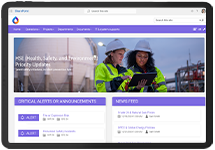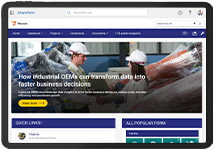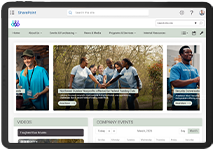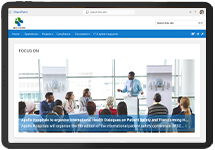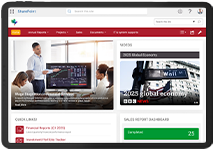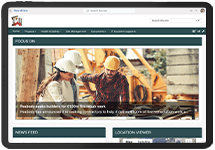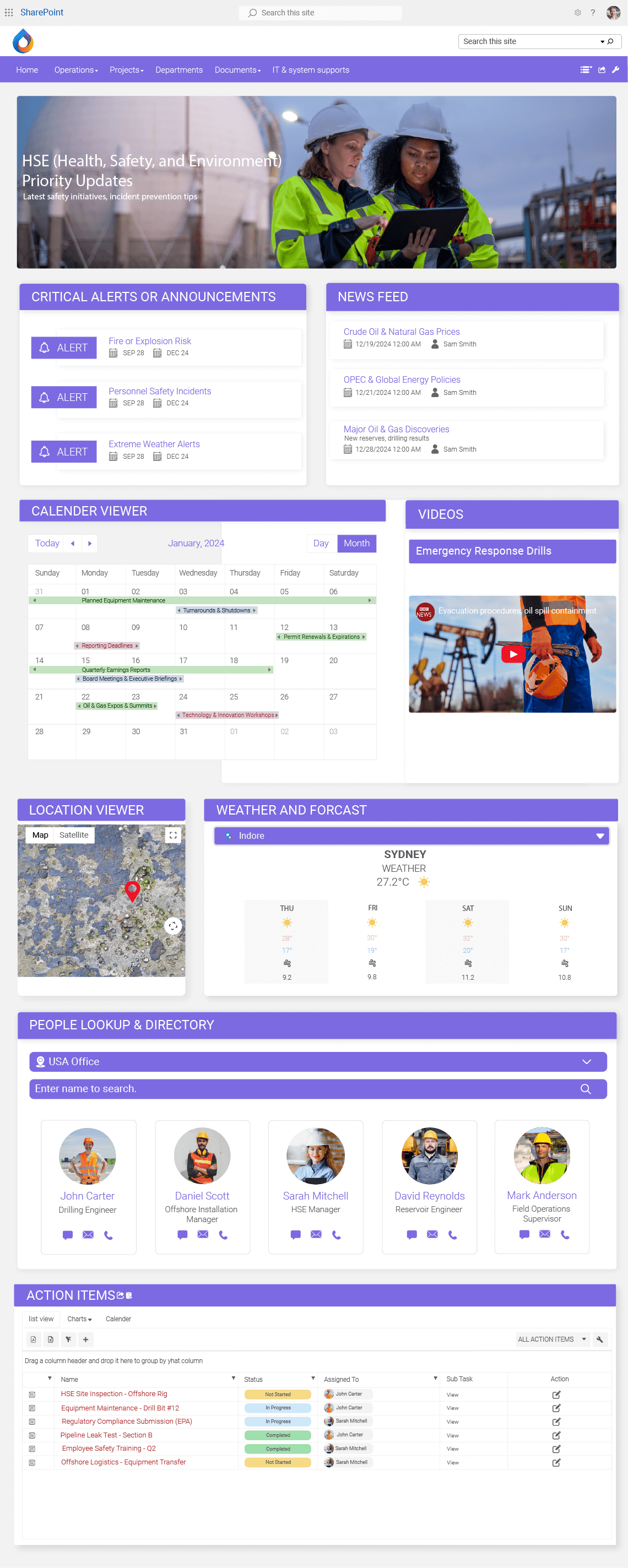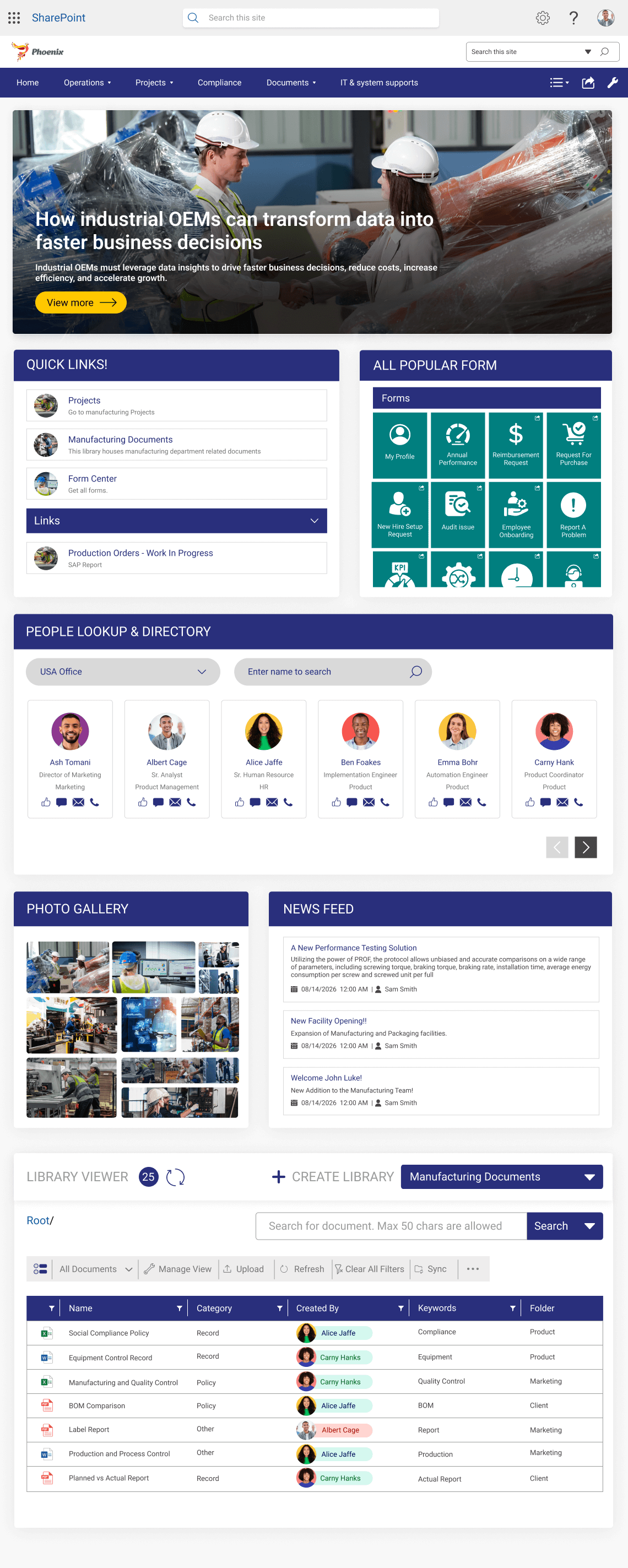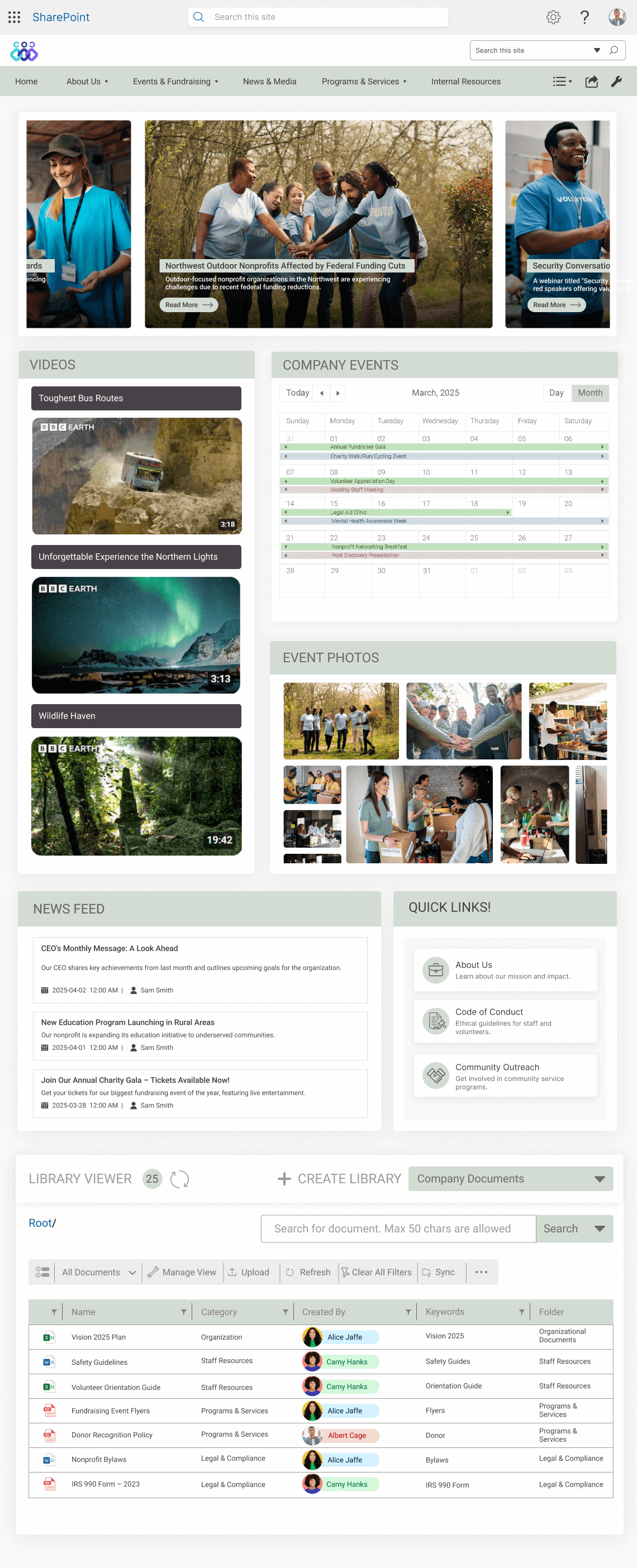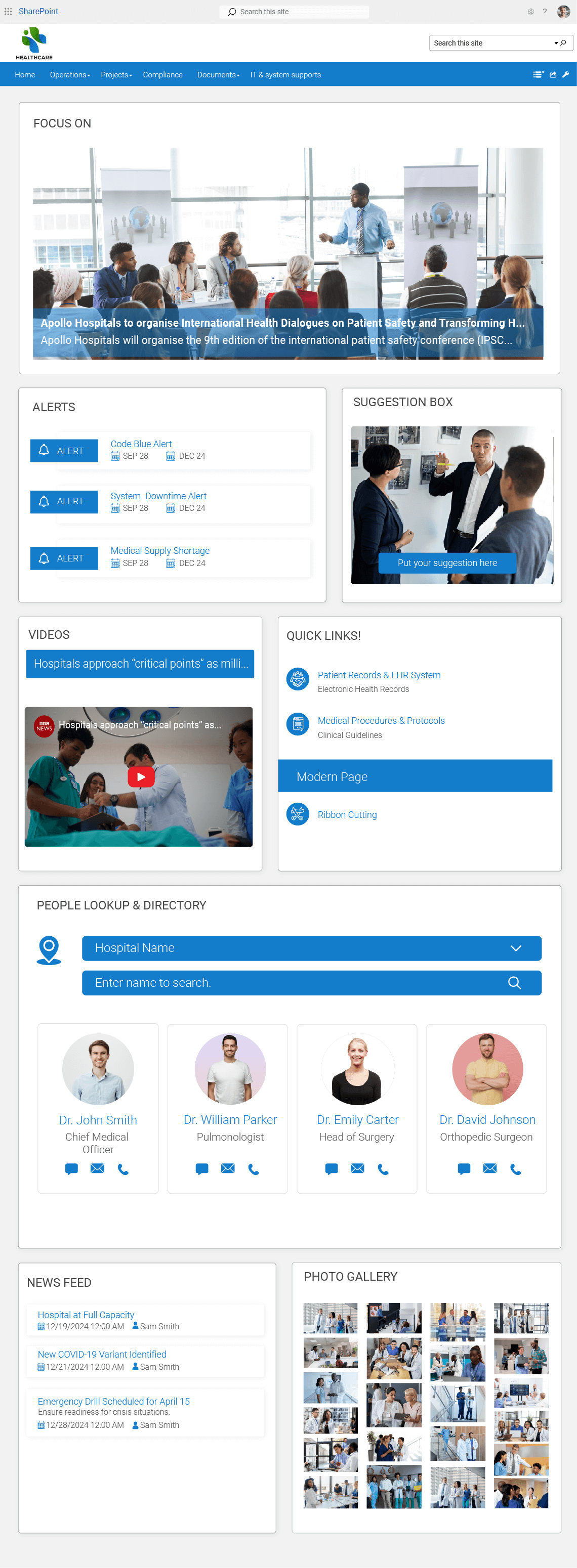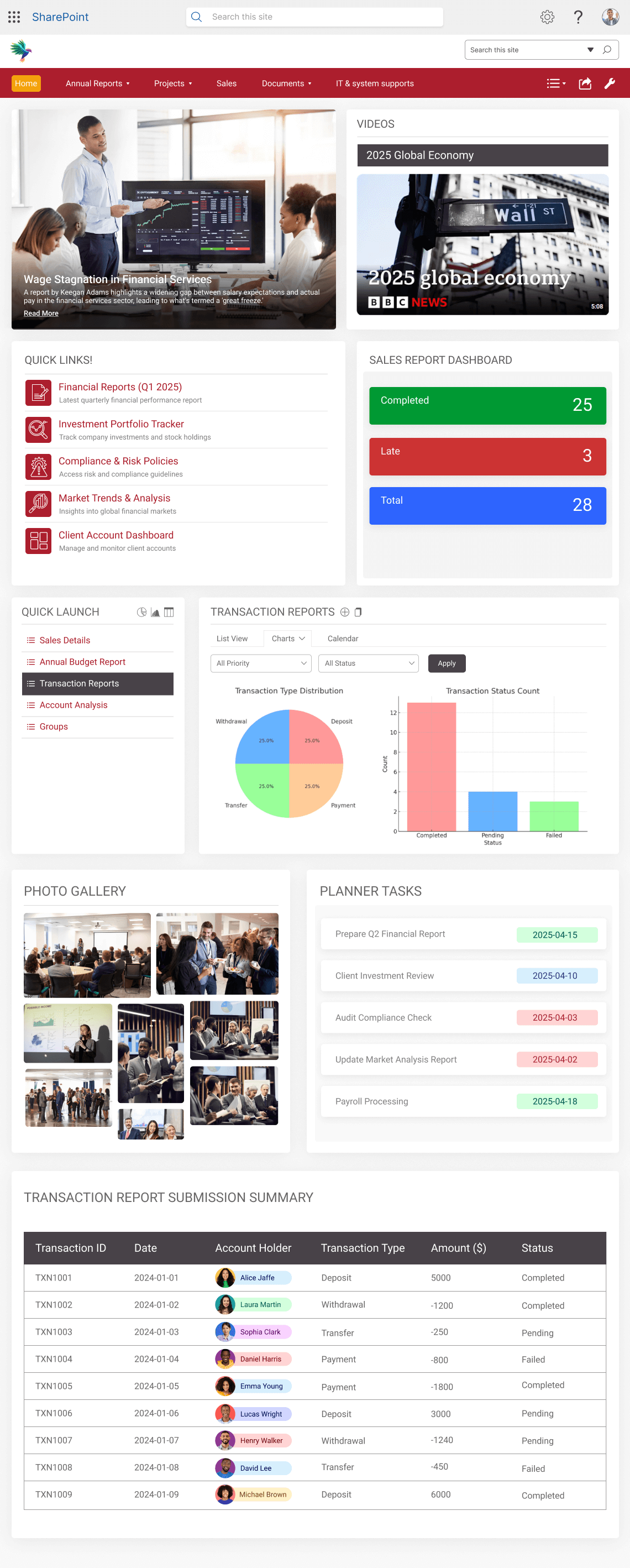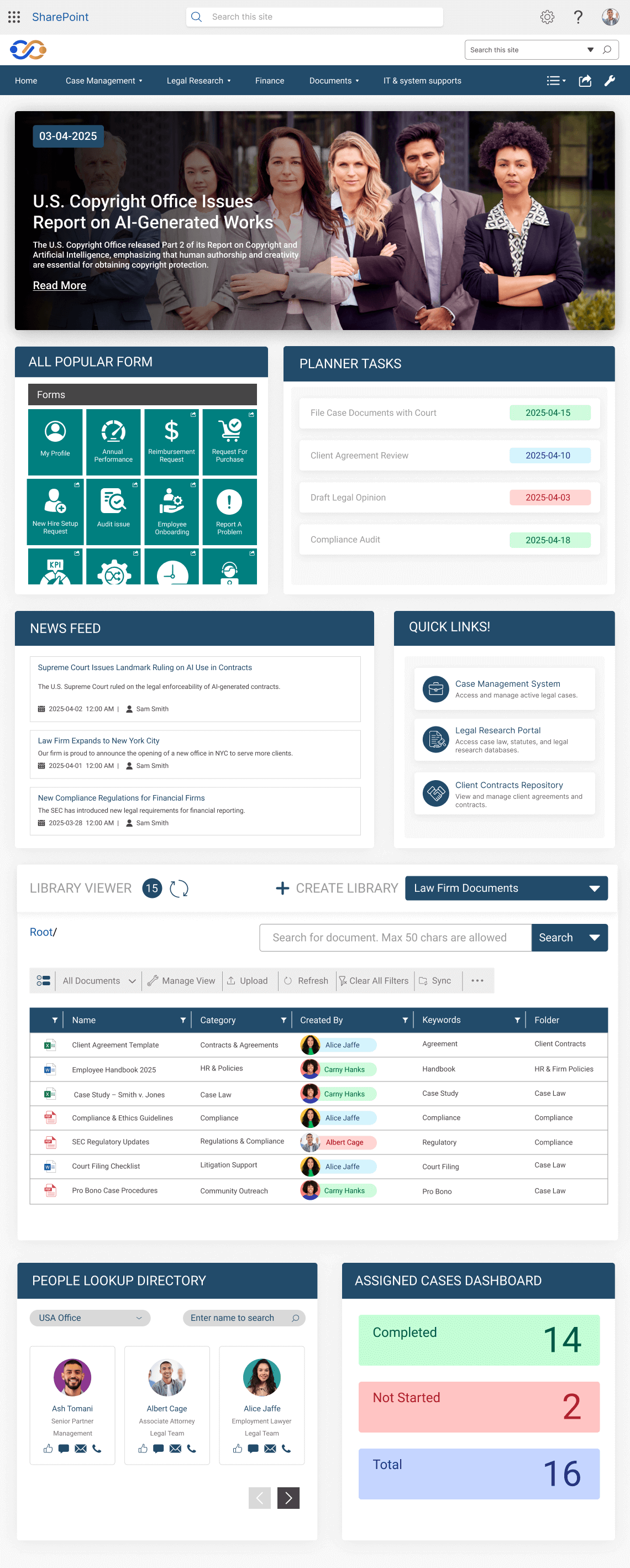In their quest to enhance employee engagement and maximize workplace productivity, contemporary organizations are increasingly looking for innovative intranet examples to inspire the creation of their own cutting-edge digital environments.
For sure, the modern intranet has evolved far beyond being just a private network for storing documents and sharing internal information. Now, what we have is a complete ecosystem where employees can connect, collaborate, and brainstorm together; manage documents and tasks; share approvals; and access relevant company updates and projects—all while working from different cities and in different time zones.
So, here, in this blog, we will explore some of the best intranet examples from different industries to help you gain fresh perspectives and innovative ideas for building an efficient company intranet for your own. Along with the intranet examples, we will also address common mistakes to avoid while planning or designing your intranet, helping you uncover the true potential of your workplace.
7 Intranet Examples That Leads the Way
As businesses scale, they find it difficult to effectively communicate and collaborate across different teams and departments, manage and securely access data, make informed decisions, and keep employees engaged within the organizations. However, many reasons contribute to these workplace challenges, such as:
Let’s assume the modern intranet is a central nervous system of your organization, much like how the brain coordinates various functions of the human body parts. It acts as a central communication hub that ensures smooth information sharing, quick decision-making, and collaboration across remote teams and departments.
However, how can studying different intranet designs or company intranet examples help you create an ideal digital environment?
There are many factors that play a crucial role in the overall success of a
company intranet. Exploring different examples of intranets can help you understand the layouts, user interface, tools, navigation, search functions, and security levels that have been used by the experts to customize their intranets according to their specific needs.
Company Intranet Example for Oil and Gas Sector
Visualizing the oil and gas sector, you can picture teams operating in remote offshore rigs or oil fields with stringent safety regulations due to high-risk environments. Indeed, the hidden challenges in the upstream, midstream, and downstream operations in the oil and gas sector need a collaborative platform that facilitates uninterrupted communication, productivity, and workplace efficiency—an ideal intranet example from this sector must address all these sectors.
The professionally designed homepage reflects the organization’s branding, with a clean, easy-to-navigate layout and a mega menu with clear fields like operations, projects, compliance and regulations, documents and resources, IT & system supports, etc. With a maximum of their teams working from remote locations, the hero web part can be used to display critical alerts or announcements such as production targets, safety statistics or protocols, images or videos of sustainability programs, corporate events, or employee achievements.
Furthermore, the homepage can display essential dates, events, and deadlines for safety audits, scheduled maintenance, inspections, employee training sessions, or certification deadlines to enhance employee engagement.
Apart from this, leveraging dedicated project sites, task trackers, separate document libraries with customizable metadata columns, or displaying localized weather information, weather-related alerts, a team member’s profile, and contact information can help employees perform their tasks with ease and efficiency.
Intranet Example for Manufacturing
The
manufacturing intranet example is customized to manage remote production sites, streamline floor operations, promote employee training, handle supply chain disruption, track production resources, and more.
The homepage of the intranet portal focuses on employee engagement and efficiency, with the hero section highlighting important metrics like production statistics, project statuses, or safety reminders. It can be an ideal place for employees to access key updates and announcements, such as leadership changes, new product launches, safety incidents, or new policy updates.
The landing page can also display quick-access links to documents and forms such as the safety protocol, maintenance schedule, employee handbook, incident report form, risk assessment form, downtime reporting form, and more to speed up standard operational tasks.
The much-required document libraries can be used to effectively store blueprints and CAD drawings, SOPs, maintenance logs, service records, etc., making them accessible when needed. You can also create dedicated sites or workflows for production and project management, safety and compliance, inventory and supply chain management, or any other purpose required for smoother manufacturing operations.
Intranet Example for Nonprofits
A successful nonprofit organization depends on clarity of purpose, a long-term vision, effective leadership, and flawless collaboration to ensure greater impact and sustainability. However, with rapidly evolving workplace technologies, how can an intranet help serve the purpose?
Let’s explore an intranet example from the nonprofit sector and understand the key areas to focus on while preparing an ideal intranet.
A
nonprofit intranet is more like a centralized communication hub, with a dominating homepage to help the leadership directly communicate with the employees and volunteers. It acts as a one-stop solution for managing internal communication, monitoring campaign status, and accessing internal or external policies and training materials, among others.
It must have a section where employees can access organization-wide news and announcements, like fundraisers, volunteer opportunities, mission-related stories, press releases about new programs or achievements, talk about their experiences, or engage in interactive discussions with other volunteers.
With
robust document management and control, teams can easily centralize key policy documents, including grant application guidelines, code of conduct, volunteer safety protocols, code of conducts, etc., and leverage metadata integration for quick and timely retrieval. It becomes easy to create, edit, modify, share, and secure information within the volunteer network.
Users can create a fundraising dashboard, prepare an event calendar, leverage custom workflows and templates for event registration forms, certification, and proposals, track fundraising metrics, and create surveys to improve efficiency and transparency in delivering its mission.
Example of Healthcare Intranet
The healthcare sector faces a unique set of challenges. An
ideal healthcare intranet is tailored to offer uninterrupted communication and information sharing, safeguard patient data and medical records, handle large volumes of paperwork, and streamline complex administrative tasks. Let’s explore a detailed example of an intranet, specifically tailored to the healthcare sector, and understand the key factors to keep in mind while preparing an ideal healthcare intranet.
An ideal healthcare intranet offers centralized document libraries to securely manage patient records, including medical histories, test results, prescriptions, and treatment plans, and store clinical guidelines, SOPs, and treatment protocols to foster evidence-based practices. Quickly accessible, digital documentation reduces human errors, ensures consistency, and promotes informed decision-making. However, creating a dedicated patient portal also aids in record management and empowers patients to access their health and wellness information, empowering them to participate in their health care journey actively.
You can offer a secure instant messaging option to healthcare workers to quickly communicate with colleagues or management or add quick links to standard resources and tools for enhanced productivity. Also, as shown in the healthcare intranet example, you can use the home page to share organizational updates, policy changes, mission, and accomplishments; post surveys and polls; or add a suggestion box to amplify your employee engagement efforts.
Customizing an intranet based on the administrative workflow and automating tasks, such as managing HR resources, employee onboarding, timesheets, payroll, etc., eventually streamlines and standardizes the day-to-day operations.
Intranet Example for Financial Teams
Example of an intranet for financial sector:
The
financial intranet example showcases an ideal homepage with essential features to facilitate internal communication, employee engagement, and workplace productivity. What else can we add to a financial intranet to utilize its full potential? Let’s understand.
For sure, financial institutions operate in a strictly regulated environment where efficiency, security, and compliance play a huge role. A few core factors like proper navigation, customization, role-based access control for stakeholders, and user-friendly interface can help create a dynamic workplace environment.
Furthermore, leveraging features like document management and control to create, edit, store, and share key documentation like client contracts, portfolios, or investment plans, or create custom lists for tracking account activities or client portfolios. In SharePoint environment, by using Power BI you can dashboards to visualize these lists and other client-related data like financial health indicators, investment returns, etc., in interactive graph or pie chart format for better data analysis and visualization.
Again, you can leverage multiple webparts to view and track upcoming events or meetings, audit schedules, training resources, tasks progress, policy review timelines, client inquiries, and more—all in one place.
Intranet Example for Construction Sector
An
ideal intranet for the construction sector should be tailored to address industry-specific challenges such as scattered communications, extensive documentation, collaboration hurdles, managing field operations, and minimizing risks on-site.
The example of an intranet shown in the above image focuses on offering a robust platform for enhanced employee engagement and productivity.
From a striking hero section displaying news feeds to a captivating video gallery highlighting construction safety basics, you can also include a map showcasing all your project sites, a centralized search bar, and quick links to essential resources. Also, having a separate section to display popular forms like daily activity reports, mileage reimbursements, employee onboarding, vendor registration, etc., can speed up data collection and avoid delays in administrative tasks.
Furthermore, the dedicated subsite for different projects helps manage project-related documents (including blueprints, construction plans, and safety reports), visualize project data, resource allocation, and progress monitoring, and access key timelines and milestones to keep track of inspection schedules, team meetings, and material deliveries.
Given the high-risk nature of construction, it becomes essential to conduct regular safety audits, track compliance, and manage risks associated with the projects. Incorporating robust document control features like versioning, audit trails, automated approvals, and metadata integration can significantly improve efficiency.
Law Firm Intranet Example
Law firms operate in a high-stakes environment where efficiency, collaboration, and security are paramount. However, think of a few fundamental challenges that a law firm faces amidst the rising number of cases and growing competition.
Manually performing case management, creating a legal research database, standardizing internal processes according to industry standards, tracking case progress, etc., can often obstruct routine operations. An ideal example of an intranet that can be an inspiration for your digital workplace solution must:
An ideal intranet serves the purpose of offering dedicated sites with separate document libraries for efficient and centralized case management. Paralegals can store case-related documents, including pleadings, motions, contracts, or discovery files; add permission levels to maintain the integrity of the case information; or easily track case-related timelines and tasks through the Kanban board and Gantt chart more efficiently than before.
Furthermore, the legal staff can leverage a centralized search option to quickly access documents, team members, notices, events, and tasks and engage in 1:1 chat, video calls, or share files for efficient collaboration, even in remote or hybrid work settings.
Common Mistakes to Avoid While Planning an Intranet
1. Overcomplicating the Design
Companies, in order to create a feature-rich intranet, often overcomplicate the design and end up with a complex mega menu and unnecessary subpages, leading to lesser adoption rates. Keeping the design clean and logically arranging essential tools or web parts can help improve navigation and overall workplace efficiency.
2. Ignoring Employee Feedback
It’s the employees who are the actual end-users of the intranet. Try involving employees in the early planning process and determining their needs, preferences, and pain points. You can conduct surveys and polls once the intranet has been rolled out to understand the effectiveness of the functionalities.
3. Failing to Integrate with Existing Tools
An intranet that lacks third-party integration turns into another isolated hub, forcing employees to switch between different applications for every other task. While leveraging the SharePoint intranet allows smoother integration with broader Microsoft 365 applications like Teams, Outlook, OneDrive, etc., it also allows third-party integration with CRMs, ERPS, and more to offer a unified workplace experience.
4. Overlooking Security & Compliance
Failing to implement robust security measures and ensure compliance with relevant industry regulations can lead to data breaches and legal actions. However, prioritizing role-based access, multi-factor authentication, customizing processes to meet compliances, incorporating audit trails, document retention policies, and more can help you create a secure and reliable environment.
5. Not Providing Sufficient Training & Support
While an intranet should simplify workflows and save time, without proper training, it could make tasks more complicated than they were before. Still, creating user-centric designs, conducting comprehensive training programs, and developing user guides and help resources can help employees use the intranet to its full potential.
6. Lack of Clear Ownership & Governance
An intranet is a living system, and it constantly evolves with your organization. However, without defining clear ownership and responsibilities, it becomes outdated. Define clear guidelines for content creation, set access controls and approval processes, and assign key stakeholders as owners and managers to ensure regular and accurate updates.
BizPortals 365 Intranet: A Configurable Intranet to Meet Your Industry Specific Requirements
BizPortals 365, a configurable, SharePoint-based intranet, is exactly what you need. With robust features to manage tasks, projects, documents, and employees, it offers seamless integration with Microsoft 365 and third-party applications for better operational efficiency. While you can customize the look and feel to give a personalized touch by using vibrant colors and themes, you can also tailor the architecture and workflows according to your business needs. BizPortals 365 serves as an excellent example of an intranet that can be used when planning your company’s intranet.
Want to see how it works? Feel free to book a live demo to see its capabilities firsthand.

